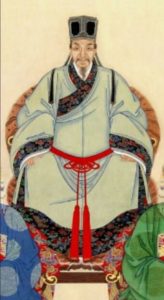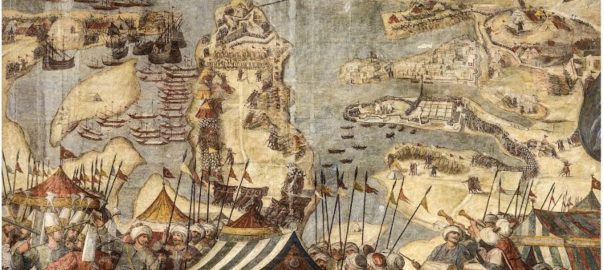Lots going on in 1565 CE– and a slightly new format here. Headlines and even an index. Click away!
- Ottomans besiege Crusader-remnant Knights in Malta
- Spanish Conquistador forces a “Treaty” on Rajah in today’s Philippines
- Another Conquistador attacks French & indigenes in today’s Florida
- Portuguese & Japanese battle at Fukuda Bay
- Key Ming military planner dies
Ottomans besiege Crusader-remnant Knights in Malta
Back in 1560, the Ottoman fleet had tried and failed to take Malta, where the last remnants of the Crusader-era “Knights Hospitallers” were holed up… and then they’d proceeded to take Djerba, off the southern end of today’s Tunisia. In early 1565, Suleiman the Magnificent tried again to take Malta. He dispatched from Constantinople to Malta a fleet consisting of 193 vessels, which would be joined by another detachment coming from North Africa and led by a corsair (privateer commander) called Dragut.
Malta is a sizeable, rocky island which already had numerous very impressive fortifications. The Turkish fleet arrived in May and started landing some of their numerous fighting forces. There followed several months of large-scale battles by land and sea, during which the Knights received reinforcements sent by the Spanish Empire and a number of other Christian European powers. By early September, the Ottomans had been defeated. They had lost an estimated one-third of their number to combat and disease (estimates vary wildly.) The survivors sailed away from the island on September 13.
(The image above is a 1581 painting of the Great Siege of Malta.)
Spanish Conquistador forces a “Treaty” on Rajah in today’s Philippines
In 1564, Spanish conquistador Miguel López de Legazpi had, as we saw, started to sail from the coast of today’s Mexico across the Pacific to today’s Philippines. On April 15, 1565, his expedition anchored in the coastal city-state of Cebu, where the ageing ruler, Rajah Tupas had met and negotiated with Ferdinand Magellan 44 years earlier, when Tupas was still just a diplomat. When Tupas heard the Spaniards had returned, he evacuated the town and relocated to the interior of the island. That may have seemed a smart move. But in the absence of Tupas, López de Legazpi simply declared that the Cebuanos had submitted to Spanish suzerainty 40 years before and therefore were today rebellious Spanish subjects. The Spanish sacked the town, began construction of a stockaded camp, and took possession of the whole island of Cebu in the name of Spain.Three weeks later, Tupas presented himself at the Spanish fort and agreed to formalize a treaty, which happened on July 3, 1565.
Historian William Henry Scott has described the treaty as “actually the terms of an unconditional surrender. … a kind of prototype of the unequal treaties which western nations were to fasten on Oriental peoples for the next three centuries.”
Another Conquistador attacks French & indigenes in today’s Florida
Pedro Menéndez de Avilés was born to a large family in Asturias, Spain. He sopent much of his young adulthood taking part in sea-battles in the Bay Biscayne against the French, soon realizing that if he built his own boat he could make more money at the job. He won his first victory of command in an engagement with French corsairs who had attacked three slow Spanish freighters off the coast of Galicia and started becoming a little famous… In 1554, he was appointed by the Crown as “Captain-General of the Fleet of the Indies,” a challenging and prestigious position that involved bringing the Spanish treasure fleet safely from from the Americas with all its heavy and precious cargo of looted silver and gold. This was the first time the Spanish Crown had made that appointment, which had previously been made by the the Casa de Contratación (House of Trade) in Seville. His first year out, he succeeded and brought the looted riches safely back to Spain.
Menéndez’s whole career was really interesting. But here we were in 1565. After some political troubles back home in Spain he had finally been released from prison, and he persuaded King Philip to appoint him as “Adelantado of La Florida”, as that long peninsular was already called– with the promise of a large land grant and the title of marquis if he was successful. Philip also gave him an asiento that granted him expansive trade privileges, the power to distribute lands, and licenses to sell 500 slaves. His mandate was to reconnoiter North America from the Florida Keys to present-day Canada and report on its coastal features, with a view to establishing a permanent settlement for the defense of the Spanish treasure fleet. He was also ordered to drive away any “intruders” who were not subjects of the Spanish crown. (The Spanish already knew about the colony the french Huguenots had established in Florida.)
On July 28, 1565, Menéndez set sail from Cádiz with a fleet led by his 600-ton flagship and several smaller ships, and carrying over 1,000 sailors, soldiers, and settlers. On the feast day of St. Augustine, August 28, the fleet sighted land and dropped anchor at the place they named St. Augustine. Three weeks later he marched his soldiers along to where the French fort was, and destroyed it, killing the 132 Frenchmen inside.
Portuguese & Japanese battle at Fukuda Bay

Various Portuguese adventurers/conquistadores had been doing business– often in partnership with Chinese wokou pirates– with Japanese feudal lords since 1543, and they had had various adventures up and down the coast of the island of Kyushu. At some point, the armed merchants in the Portuguese fleets had been supplemented by Jesuits, and in 1563, one Japanese feudal lord (daimyo), Ōmura Sumitada, had even converted to Christianity.
In 1565 Portuguese conquistador João Pereira brought a carrack (a large armed trading ship) into an Ōmura-controlled anchorage in Fukuda Bay. A daimyo rival of Ōmura’s was angry/jealous about that decision and sent a flotilla of the much smaller Japanese boats to attack it. When the flotilla arrived on October 18, most of the big ships crew was on shore, leaving “only about 80 Europeans on the flagship, along with an uncounted number of black slaves and Chinese merchants taking refuge on board.” The Japanese attackers were able to board the carrack, and one even shot a musket at Pereira, “denting his helmet.” But then a large Portuguese galleon sailed up and the two Portuguese boats were able to catch the Japanese boats in their crossfire, sinking three of their boats and killing over 70 men. The victorious carrack, suffering only 8 lives lost, set sail for Portugal’s base in Macao, China, at the end of November.
The local Jesuits wrote jubilantly of the Portuguese victory, which increased the prestige of the Portuguese in the eyes of the Japanese. The Japanese also came to respect the superiority of Western gunpowder weapons. The Portuguese continued to call at Fukuda and the nearby Kuchinotsu for a few more years, until Ōmura Sumitada offered the Jesuits the nearby port of Nagasaki, a mere fishing village at the time. From 1571 onward the Portuguese traders focused their activities on Nagasaki, turning it into the hub of Japan’s foreign trade and its window to the West until the 19th century.
Key Ming military planner dies

Meantime, in China, the Jiajing E,peror was falling ill in 1565… But the year also saw the death of another interesting Ming military official, Hu Zongxian. Back in 1548, we’d looked at the career of and earlier Ming-era pirate-fighter Zhu Wan, who did well until he came to an abrupt and end, his work undercut by the Jiajing Emperor…. Now, in 1565, we learn of the death in broadly similar circumstances of Hu Zongxian, whose earlier main job in Zhejiang and neighboring regions, 1555-63, had also been to confront that same very expert Chinese wokou (pirate), Wang Zhi whom Zhu Wan had been fighting.
Wang Zhi was a big deal who dealt confidently and very impudently with the Ming authorities: “On 17 October 1557, Wang Zhi arrived at Zhoushan Island with a large trading fleet. There he laid down his terms for surrender: he sought an imperial pardon, a naval commission, and that ports be open for trade; in return he offered to patrol the coast and persuade the raiders to return to the islands through force if necessary… In December, confident in his prospects and his invulnerability, Wang Zhi made landing at Hangzhou. There he was accorded respectable treatment by the authorities, who feared antagonizing his followers, while they figure out what to do with him. During this time Hu Zongxian asked Wang Zhi to help manufacture arquebuses for the Ming army… Finally in February next year, Wang Zhi was sent to prison, where he was given the luxuries of novelties, books, and healthy foods. Wang Zhi believed this was a temporary arrangement and remained hopeful for a pardon until 22 January 1560, when an imperial edict handed down the death sentence, and he was summarily beheaded.”
Despite some continuing trouble dealing with piratical hard-liners, Hu Zongxian ended up doing pretty well in defeating them and basked in public adulation until — drumroll– the Jiajing Emperor turned against him, too…
Hu was reportedly an ancestor of Hu Jintao, who was the PRC’s leader 2002-12.
